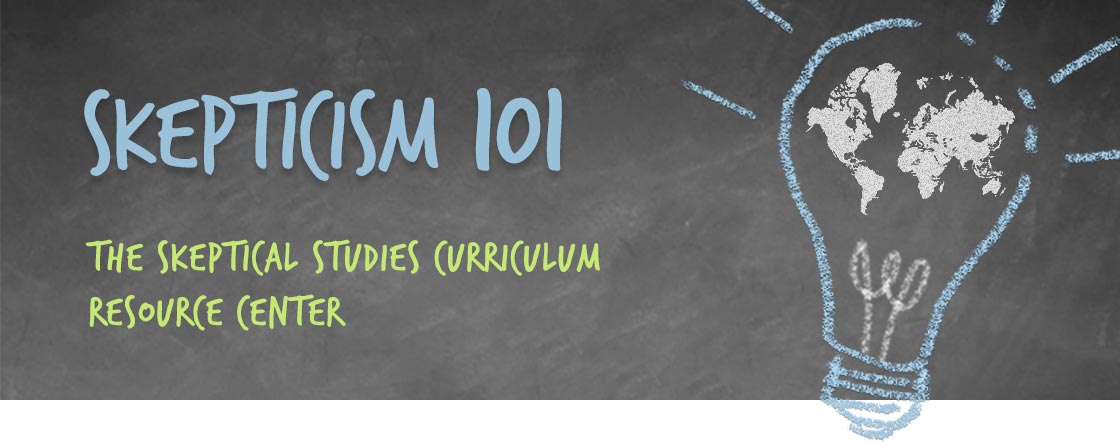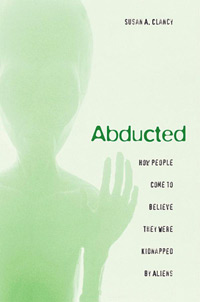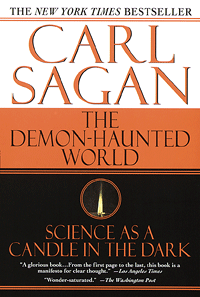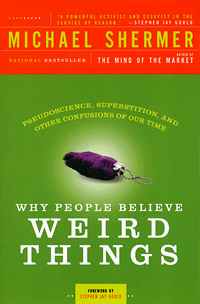You Are Browsing Resources on:
ufos/aliens/crop circles
Dr. Michael Shermer examines the claims about the Bermuda Triangle using the tools of skepticism, science, and rationality to reveal that there is no mystery to explain. Selective reporting, false reporting, quote mining, anecdote chasing, and mystery mongering all conjoin to create what appears to be an unsolved mystery about the disappearance of planes and ships in this triangular shape region of the ocean. But when you examine each particular case, as did the U.S. Navy, Coast Guard, and especially insurance companies who have to pay out for such losses, it becomes clear that almost all have natural explanations, and the remaining unsolved ones are lying on the bottom of the ocean beyond our knowledge.
Skepticism 101: How to Think Like a Scientist covers a wide range of topics, from critical thinking, reasoning, rationality, cognitive biases and how thinking goes wrong, and the scientific methods, to actual claims and whether or not there is any truth to them, e.g., ESP, ETIs, UFOs, astrology, channelling, psychics, creationism, Holocaust denial, and especially conspiracy theories and how to think about them.
If you missed Dr. Shermer’s previous Skepticism 101 lectures watch them now.
Dr. Michael Shermer distinguishes between two questions: (1) Are extraterrestrial intelligences (ETIs) out there somewhere in the cosmos? and (2) Have aliens come here? Evidence for both questions is considered in the larger context of why the issue so compels us to answer it almost religiously.
Skepticism 101: How to Think Like a Scientist covers a wide range of topics, from critical thinking, reasoning, rationality, cognitive biases and how thinking goes wrong, and the scientific methods, to actual claims and whether or not there is any truth to them, e.g., ESP, ETIs, UFOs, astrology, channelling, psychics, creationism, Holocaust denial, and especially conspiracy theories and how to think about them.
If you missed Dr. Shermer’s previous Skepticism 101 lectures watch them now.
Mentioned in this lecture
Related Reading
Dr. Michael Shermer considers the characteristics of cults, how they differ from sects, religions, and myths, the role that myths and religions play in culture and people’s lives, and what Scientologists really believe.
Skepticism 101: How to Think Like a Scientist covers a wide range of topics, from critical thinking, reasoning, rationality, cognitive biases and how thinking goes wrong, and the scientific methods, to actual claims and whether or not there is any truth to them, e.g., ESP, ETIs, UFOs, astrology, channelling, psychics, creationism, Holocaust denial, and especially conspiracy theories and how to think about them.
If you missed Dr. Shermer’s previous Skepticism 101 lectures watch them now.
This course was taught at Florida State College at Jacksonville during the spring 2013 semester.
Excerpt from Syllabus
An interdisciplinary study of selected topics in the biological and physical sciences and their impact upon man and society, with the course format including seminar, discussion and projects. Topics will vary…. genetics, tissue culture, space, Malthusian theory, light, sound, and mechanics. This course will provides students with a unique opportunity to examine many common pseudoscientific fallacies, learn how the human brain has evolved to encourage paranormal beliefs, and challenge the students to confront their own biases as they apply the scientific method to their own beliefs through in-class activities, experiments, and research projects.
DOWNLOAD THIS RESOURCE
(150 kb PDF)
This course was taught at the University of Texas at El Paso during the spring 2013 semester.
Excerpt from Syllabus
This course is designed to introduce students to a variety of critical thinking skills and to encourage them to practice those skills in the context of evaluating popular claims, especially extraordinary claims about topics relevant to anthropology and archeology. It is intended for students who are attracted to the interesting topics identified with anthropology in the popular media, but the level of instruction assumes no prior experience in anthropology. Students will learn about the methods used to interpret the physical traces of behavior, and how to distinguish scientific arguments from pseudoscience and non-science. Lectures, readings and class exercises will examine a variety of non-scientific explanations for past and present events, such as UFOs and ancient astronauts, Bigfoot, pyramid power, Atlantis, creationism and intelligent design, the Book of Mormon, dowsing, climate change denial, and psychic archeology.
Does Bigfoot roam the mountains of Oregon, and do his cousins hang out in the Sacramento Mountains of southern New Mexico? Are they shape-shifters, or do they use wormholes to travel the time-space continuum? Are extraterrestrial aliens like the ones who crashed in Roswell, New Mexico silvers or greens? Is there really an exotic blood-sucking animal called chupacabra killing livestock in the southern U.S. and northern Mexico, or is it just a hairless raccoon? Should we believe Senator James Inhofe when he says that global climate change is a hoax? Is cell phone use harmful to your health? Do the Power Balance bracelets worn by Drew Brees and Kobe Bryant provide any real scientific advantage to athletes? Are modern humans related to ancient prehistoric peoples, or were we created in modern form? Is there reliable evidence to support the claims that psychics can reveal details about the past or make valid predictions about the future? Was planet earth really visited by ancient astronauts, and did they teach Egyptians how to build the pyramids? How can we know the answers to such questions? In fact, how can we know the truth about any claim? We are bombarded by information and claims all the time, and it is vitally important, now more than ever, that we be able to distinguish valid information and warranted conclusions from those that are not. How can we do this, especially when the claims involve events that occurred in the prehistoric past, were not witnessed by humans, or were not documented in written records?
DOWNLOAD THIS RESOURCE
(4 MB PDF)
This course was taught at the California State University, Northridge during the fall 2010 semester.
Excerpt from Syllabus
One of the characteristics of contemporary American popular discourse is a marked increase in irrationalism. Belief in the paranormal, pseudoscience, and millenialism is perhaps more prevalent than at any other time in the history of Western Civilization. This course seeks to test these beliefs through the application of rhetorical analysis and critical thinking to discourse advancing extraordinary claims.
Learning Goals
Upon successful completion of this course, the students will be able to:
- Identify extraordinary claims in popular discourse.
- Identify the types of appeals, including forms of reasoning and evidence, used to advance extraordinary claims in popular discourse.
- Assess the strength of rhetoric advancing extraordinary claims.
- Prepare critical analyses and refutations of rhetoric advancing extraordinary claims.
DOWNLOAD THIS RESOURCE
(118 kb PDF)
This book was required reading for “Why We Believe Weird Things: Science and Pseudoscience in Psychology” taught by Dr. Jeffrey Brookings and for “Parapsychology & the Occult” taught by Dr. Terence Hines.
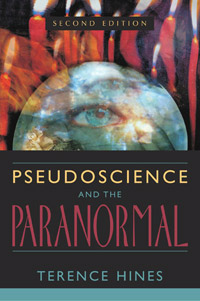
Popular culture fills the mind with a steady diet of fantasy, from tales of UFO landings and alien abductions, haunted houses, and communication with the dead to claims of miraculous cures by spiritual healers and breakthrough treatments in ‘alternative’ medicine. The paranormal – and the pseudoscience that attempts to validate it – is so ubiquitous that many people lose sight of the distinction between the real and the imaginary, and some never learn to make the distinction in the first place. In this updated and expanded edition of “Pseudoscience and the Paranormal”, the most comprehensive and up-to-date work of its kind, psychologist and neuroscientist Terence Hines explores the question of evidence for the paranormal and delves beyond it to one that is even more puzzling: Why do people continue to believe in the reality of the supernatural despite overwhelming evidence that it does not exist? Devoting separate chapters to psychics, life after death, parapsychology, astrology, UFOs, faith healing, alternative medicine, and many other topics, Hines examines the empirical evidence supporting these popular paranormal and pseudoscientific claims. New to this edition are extended sections on psychoanalysis and pseudopsychologies, especially recovered memory therapy, satanic ritual abuse, and facilitated communication. Also included are new chapters on ‘alternative’ medicine and environmental pseudoscience. Critiquing the whole range of current paranormal claims, this carefully researched, thorough review of pseudoscience and the paranormal in contemporary life shows readers how to carefully evaluate such claims in terms of scientific evidence. This scholarly yet readable volume is an invaluable reference work for students and general readers alike. —Amazon
BUY THIS BOOK
from Amazon
This book was required reading for Jeffrey Brookings’ course, “Why We Believe Weird Things: Science and Pseudoscience in Psychology” taught at Wittenberg University during the fall 2010 semester.
They are tiny. They are tall. They are gray. They are green. They survey our world with enormous glowing eyes. To conduct their shocking experiments, they creep in at night to carry humans off to their spaceships. Yet there is no evidence that they exist at all. So how could anyone believe he or she was abducted by aliens? Or want to believe it?
To answer these questions, psychologist Susan Clancy interviewed and evaluated “abductees”–old and young, male and female, religious and agnostic. She listened closely to their stories–how they struggled to explain something strange in their remembered experience, how abduction seemed plausible, and how, having suspected abduction, they began to recollect it, aided by suggestion and hypnosis.
Clancy argues that abductees are sane and intelligent people who have unwittingly created vivid false memories from a toxic mix of nightmares, culturally available texts (abduction reports began only after stories of extraterrestrials appeared in films and on TV), and a powerful drive for meaning that science is unable to satisfy. For them, otherworldly terror can become a transforming, even inspiring experience. “Being abducted,” writes Clancy, “may be a baptism in the new religion of this millennium.” This book is not only a subtle exploration of the workings of memory, but a sensitive inquiry into the nature of belief. —Amazon
BUY THIS BOOK
from Amazon
Susan Clancy gave a lecture on this book at the California Institute of Technology.
BUY THE DVD
from Shop Skeptic
This book was required reading for the following courses: (1) “Science, Skepticism & Weird Behavior” taught by Bryan Lovelace, (2) “Skepticism & the Scientific Worldview” taught by Travis Knowles, (3) “Skepticism, Science & the Paranormal” taught by Martin Brigdstock, and (4) “The Scientific Method: Critical & Creative Thinking” taught by Stephen Sekula et al.
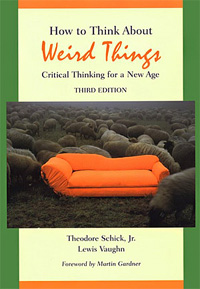
This brief text helps students to think critically, using examples from the weird claims and beliefs that abound in our culture to demonstrate the sound evaluation of any claim. It explains step-by-step how to sort through reasons, evaluate evidence, and tell when a claim (no matter how strange) is likely to be true. The emphasis is neither on debunking nor on advocating specific assertions, but on explaining principles of critical thinking that enable readers to evaluate claims for themselves. The authors focus on types of logical arguments and proofs, making How to Think about Weird Things a versatile supplement for logic, critical thinking, philosophy of science, or any other science appreciation courses.—Amazon
James Randi calls this textbook, “the most powerful, comprehensive, and readable collections of examples, explanations and caveats that I could have ever hoped for.” A library must!—Skeptic
BUY THIS BOOK
from Amazon
This book was required reading for the following courses: (1) “Skepticism 101: How to Think Like a Scientist Without Being a Geek” taught by Michael Shermer, (2) “Weird Science” taught by John Donovan, (3) “The Scientific Method: Critical & Creative Thinking” taught by Stephen Sekula et al., and (4) “Studies in Behavior: Critical Thinking” taught by Evelyn Buday.
“The great astronomer and science writer challenges New Agers and explains social phenomena like UFOs, alien abductions, recovered memories, satanic cults, witch crazes, hallucinations, and how to detect baloney. This is Sagan’s most popular book among skeptics, filled with quotable maxims, popular among college professors as a supplemental text for students, but a classic for everyone who cares about living in a sane and safe world without superstition.” —Skeptic
“Eminent Cornell astronomer and bestselling author Sagan debunks the paranormal and the unexplained in a study that will reassure hardcore skeptics but may leave others unsatisfied. To him, purported UFO encounters and alien abductions are products of gullibility, hallucination, misidentification, hoax and therapists’ pressure; some alleged encounters, he suggests, may screen memories of sexual abuse. He labels as hoaxes the crop circles, complex pictograms that appear in southern England’s wheat and barley fields, and he dismisses as a natural formation the Sphinx-like humanoid face incised on a mesa on Mars, first photographed by a Viking orbiter spacecraft in 1976 and considered by some scientists to be the engineered artifact of an alien civilization. In a passionate plea for scientific literacy, Sagan deftly debunks the myth of Atlantis, Filipino psychic surgeons and mediums such as J.Z. Knight, who claims to be in touch with a 35,000-year-old entity called Ramtha. He also brands as superstition ghosts, angels, fairies, demons, astrology, Bigfoot, the Loch Ness monster and religious apparitions. (Feb.)” —Publishers Weekly
BUY THIS BOOK
from Shop Skeptic
This book was required reading for the following courses: (1) “Skepticism 101: How to Think Like a Scientist Without Being a Geek” taught by Michael Shermer, (2) “Weird Science” taught by John Donovan, and (3) “Skepticism, Science, & the Paranormal” taught by Martin Bridgstock.
In this age of scientific enlightenment, many people still believe in mind reading, past-life regression theory, New Age hokum, and alien abduction. A no-holds-barred assault on popular superstitions and prejudices, Why People Believe Weird Things debunks these nonsensical claims and explores the very human reasons people find otherworldly phenomena, conspiracy theories, and cults so appealing. Michael Shermer takes on science luminaries like physicist Frank Tippler and others, who hide their spiritual beliefs behind the trappings of science.
Shermer, science historian and true crusader, also reveals the more dangerous side of such illogical thinking, including Holocaust denial, the recovered-memory movement, the satanic ritual abuse scare, and other modern crazes. Why People Believe Weird Things is an eye-opening resource for the most gullible among us and those who want to protect them.
BUY THIS BOOK
from Shop Skeptic
This course was taught at Davis & Elkins College during the spring 2010 semester.
Excerpt from Syllabus
This course exposes students to ongoing biological research. Published articles from scientific magazines and peer-reviewed journals will be thoroughly analyzed and discussed. As part of the course, students will be invited to watch selected episodes of Penn & Teller’s Showtime TV series “Bullshit,” which exposes and debunks pseudoscientific claims and paranormal phenomena.
Learning Goals
By the end of this course, students will be able to:
- Interpret scientific data, as presented in the literature.
- Determine whether authors’ conclusions are valid, based on the available data.
- Suggest follow-up studies to address weaknesses in current research.
- Recognize the difference between science and pseudoscience.
DOWNLOAD THIS RESOURCE
(194 kb PDF)
This course was taught at the University of Wisconsin, Oshkosh during the fall 2010 semester.
Excerpt from Syllabus
In its broadest sense, Fantastic Archaeology describes those claims and interpretations about the archaeological record that are outside the orthodox mainstream of the scholarly and professional world of archaeology. This can range from new, as yet untested hypotheses that may become the orthodox interpretations to the outrageous claims that can be easily refuted. Students will examine this entire range of competing, non-orthodox interpretations of the archaeological record.
This course has a much broader subject area than students are likely to encounter in other courses–even in an eclectic field like Anthropology. Students have the opportunity to bring knowledge and expertise acquired in other courses, or their general life experience, to the discussions.
DOWNLOAD THIS RESOURCE
(630 kb PDF)
This course was taught at Wittenberg University during the fall 2010 semester.
Excerpt from Syllabus
“Vaccines cause autism.” “Playing Mozart to infants increases their intelligence.” “Prayer cures cancer.” These and other sensational claims are reported daily by the popular media, who usually present them as factual because there is—purportedly—scientific evidence of their validity. But what qualifies as scientific evidence, and how do we distinguish scientifically-supported conclusions from plausible-sounding but unsubstantiated, untestable assertions? In this course, we begin by defining what science is and how it differs from pseudoscience. We then consider the basic perceptual and cognitive mechanisms through which humans gather and process information, emphasizing errors in thinking and reasoning that, despite scientific evidence to the contrary, predispose us to believe, “weird” things.
Finally, we will use what we have learned to investigate phenomena of particular interest to behavioral scientists and paranormal investigators, including subliminal perception and persuasion, astrology, near death experiences, criminal profiling, alien abduction stories, repressed memories, and “new” psychotherapies. Our goal is to be open to novel claims, coupled with the determination to subject those claims to careful scientific scrutiny.
Learning Goals
In this class, students will:
- Learn how science and pseudoscience differ, and why the difference matters.
- Explore human perception, cognition, memory, and emotion, including errors and biases that lead us to believe “weird things.”
- Develop tools for conducting skeptical analyses of extraordinary claims.
- Sharpen writing and oral presentation skills.
- Design, complete, and present an investigation of an extraordinary claim.
- Lay the foundation for a successful college experience.
DOWNLOAD THIS RESOURCE
(81 kb PDF)
This course was taught at Chapman University during the fall 2011 semester.
Excerpt from Syllabus
This comprehensive course on science and skepticism will address the most mysterious, controversial, and contentious issues in science and skepticism from a quarter century of research involving: science and pseudoscience, science and pseudohistory, science and religion, science and morality, the psychology and neuroscience of belief, science and politics, science and economics, evolution and intelligent design creationism, the Baloney Detection Kit, how beliefs can be changed, how science works (and sometimes doesn’t work) from the history of science, and many specific examples of the power of belief.
Using numerous examples from three decades of research on this subject, students will learn how to think scientifically and skeptically, and he will show how to be open-minded enough to accept new ideas without being so open-minded that their brains fall out. This course meets once a week for three hours and includes lectures accompanied by in-class demonstrations, videos, magic, illusions, and examples from pop culture, along with rigorous scientific research, plus student discussions and presentations.
DOWNLOAD THIS RESOURCE
(156 kb PDF)
This course was taught at Oklahoma City University during the spring 2011 semester.
Excerpt from Syllabus
This critical thinking course interprets extraordinary claims using reason, logic, and skeptical analysis in drawing conclusions. Fringe science, pseudoscientific, and bogus health claims will be evaluated based on available evidence. Health claims, fortune- telling (astrology, psychic predictions, palm reading), alternative medicine, sensory illusions such as magic, faith healing, clairvoyance, telepathy, the lunar effect, and psycho-kinesis will be some of the topics likely covered. The role of the media in covering and reporting such claims will be explored. The course will focus on drawing plausible and logical conclusions based on evaluation of existing evidence. Assignments will include weekly quizzes, class discussions, and a formal project/presentation.
Learning Goals
- Have a basic knowledge of critical thinking, skeptical thought, and the scientific method.
- Discriminate between sound vs. faulty logic in descriptions and observations of pseudoscientific claims.
- Demonstrate how to conduct research and/or investigate anomalistic phenomena via a positive working relationship with a team of students.
- Evaluate skeptical knowledge of unexplained phenomena, its claim(s), or a central skeptical figure.
DOWNLOAD THIS RESOURCE
(194 kb PDF)
Synthesizing thirty years of research, Michael Shermer upends traditional thinking about how humans form beliefs about the world. Simply put, beliefs come first, and explanations for beliefs follow. The brain, Shermer argues, is a belief engine. Using sensory data that flow in through the senses, the brain naturally looks for and finds patterns—and then infuses those patterns with meaning, forming beliefs. Once beliefs are formed, our brains subconsciously seek out confirmatory evidence in support of those beliefs, accelerating the process of reinforcing them. Shermer provides countless real-world examples of how this process operates, from politics, economics, and religion to conspiracy theories, the supernatural, and the paranormal.
DOWNLOAD THIS RESOURCE
(285 MB Powerpoint Presentation)
Any Sufficiently Advanced Extraterrestrial Intelligence is Indistinguishable from God
In this brief lecture, Dr. Shermer demonstrates why the Intelligent Design creationists’ and theologians’ search for a designer god can only result in the discovery of an extraterrestrial intelligence; one with such power that it can create life, planets, stars, and even universes. As Dr. Shermer states, “Any sufficiently advanced extraterrestrial intelligence is indistinguishable from God.” In this lecture Dr. Shermer also discusses the potential trajectory of our own technological advancements.
DOWNLOAD THIS RESOURCE
(18 MB Powerpoint Presentation)

